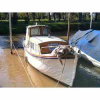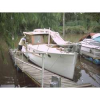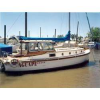Topic: Bob Frassinetti
Bob Frassinetti and the Buenos Aires Toy Museum, Argentina
1. Do you have a personal favourite toy or collection? Why is it your favorite?
Indeed I have. To me the most interesting toy are Robots. These items blend the functionality and imagination broadening qualities through means of the world of sci-fi as well as they express outstanding design and composition features that exceed the world of toys. Even foreseeing trends that would latter become key factors to design breakthrough in all sort of items. Such is the impact these items have had on society and myself –personally- that I researched and came up with a brief history of these item…
During the last few decades, toy robots have regained popularity because of the new impulse given by collectible space items. The Buenos Aires Toy Museum holds a spectacular collection of robots made or found in Argentina, as well as a very interesting input of information on the subject. This huge task of collecting and searching information is the result of a very hard work carried on by our team of specialists.
It may seem simple to define a robot, most of us would describe the first of those metallic invented creatures as one, though it's quite more complicated to come up with a general definition for robots, since there are quite a lot of variations and differences among them, which make much more complicated to come up with a general definition.
The word Robot became popular in 1922 when the Czech writer Karel Capek used it in his play R.U.R to refer to a bunch of animated creatures -created by the leading man of the story- whose main task was to work. Etymologically the word meant slave or servant in Czech, but it was redefined because of this new meaning as a servant or salve that was specially created to work instead of its creator.
As a general approach to the subject we can say that robots are machines or devices that move independently, they might be defined as a combined and mechanical system of computation and sensors that receive information through various means in order to act on it through pre-established technical or physical manoeuvres.
Nowadays there are many types of robots that adjust to this general definition. For example androids; these look-alike humans, are what we usually refer to as robots. However there are much more robots than we acknowledge as such, take for example the mobiles, these machinery that has the ability to move from one place to another independently of an immediate indication from outside, are also robots in spite of the fact that they don' t have any esthetical similarity to humans. The medical ones are specially prosthesis control systems. And the industrial robots, very common in these days, are machinery specially designed to carry on pre-established tasks within the working places. In spite of all the aesthetic and functional differences, all these robots share a common origin and mechanism.
It's quite interesting to find scale reproductions of each and every one of these robots with which millions of children play and that many adults collect because of their cultural, historical and aesthetic value. Regarding robots history, it was very common to hear during the fifties that by the next millennium there would be intelligent creatures created by man. This hasn't happened, nonetheless the amount of scientific progress in this field it's bringing much closer the possibility of that to happen. As it happens in every other aspect of life, toys have reflected the boom of robots. At first the design of these toys showed hard angled lines using clockwork mechanisms. Japanese wind-up tin robots from early 30s and 40s are the last expression of that aesthetic trend in robot design. These toys were mostly made in tin, though it was during mid 50s and 60s when plastic became the newest material in toy manufacturing, and was also incorporated into the toy robot production and design. During was is commonly known as the Atomic Era and -may be- as a reflection of the competition between the US and the URSS those hard lines in the design of toy robots were left behind, now they used rounded edges and smoother lines, plus this toys had become battery operated. It was during the sixties when these androids appearance evolved into more human features, but paradoxically it was also then when the demand for these kind of toys dropped dramatically. These amazing pieces of art, that once were the best possible present for kids, are now greatly valued collectible toys, because of their aesthetic and design, the technical evolution of the item, and because, of course, they are a trade mark of a time in men's history.
2. How are Argentine toys different from toys from other countries?
For Argentina is a melting pot kind of society, all toys made in our country reflect in every case the combination of local and immigration brought trends. In every case, non of these trends stay isolated, even more they flow into a new mainstream of being Argentine. In some cases the original materials were not available in our country, therefore, these toys were adapted and made with handy local materials. In other cases, many of the heroes or main characters were adapted to the Argentine idiosyncrasy. Take for example the traditional Monopoly game; this was early in time made for Argentine kids as El Estanciera – the landlord, featuring a more countryside life much more in tune to the Argentine society.
In recent dates, such as the 1980s, some of the most popular toys around the world such as Action Figures, GI Joe, My Little Pony, Strawberry Short Cake, appeared different from the original American models by the paintjob. For these are artistic blends, though the general feel was similar to the one made in the US, the Argentine version was hand painted one by one, making them unique in their differences. As well as inevitably including a Latino feel and sense of being transmitted by the artist who was working on these items. These features can be specifically traced in several other toys that were made in Argentina, though sold all over Hispanic South America.
3. What are some traditional Argentine toys?
There are three different kinds of traditional toys. First, we can point out those toys that can be purchased in stores. In the majority of the cases, these were in big cities such as Buenos Aires, Rosario, Cordoba, Santa Fe. Both Argentine and imported toys could be acquired there and they were very similar to those all over the world. Dolls, toy cars, trains, balls, led soldiers, carting… plus all sort of rural toys related to our fields, the main support to our nation’s income. Our research work has showed us toys –in most of the cases- as reflection of reality. Secondly we can point out what we have christened as popular toys. These in most of the cases were made at home… a sort of joint venture between children and parents, handcrafted, one of a kind item, totally imaginative, seldom copies, and always made with handy, not very sophisticated materials. Love affection proofs of a father or mother to their child. To our surprise in recent dates of economic crisis and turmoil, these kinds of toys are creeping back into the children’s bedroom.
Last but not least, we have found another kind of traditional toy; these are what we have labelled –in lack for a better term- “ethnic toys”. To be found only today in rural communities of aboriginal groups that continues to practice their ancestral culture. These are always made out of natural fibbers and rarely stand the pass of time. The near impossibility of having original examples is sometimes sorted out by anthropologists and archaeologists kind enough to work together with us sharing their research work progress.
4. Why did they stop making the Buby and Muky toys from the (50's to the 80's)?
Toy production in Argentina has always been at a medium scale, not very big companies, even more in many cases these were small industries. They were always very much dependent on the ups and downs of our economy. The constant cycles have caused industries to open, grow, flourish, close, and in many cases disappear without a trace. It is here that our personal quest to recover and rescue from oblivion the history of Argentine toys. For the worldwide impact and acceptation of Argentine toys rests mainly on the great quality, design and imagination of the Argentine entrepreneurs. The 80s were a hard economic turndown that was completed during the 90s with the vanishing of a prolific industry of quality and design. That was the end to the wonderful Buby and Muky die casts.
5. What is the most requested toy?
This varies in relation with the public. As we go finding old and rare examples of toys of our past, we research on them, and publish articles throughout the world in specialized reviews or webzines, people go reading and learning and emailing us.
But most likely the most popular toys that we ever sold were GI Joe’s action figures 3 ¿ inches, My Little Pony and Transformers.
6. What was the hardest toy to search out?
The hardest toys are definitely the oldest ones, especially if you want to find it in good condition and with original features. Die cast toys are may be the most popular toys to kids from all over the world, who even after childhood have kept a close spot in their hearts for these sort of toys. May be the most looked for are Buby’s die cast Estanciera, a scale reproduction of Kaiser-IKA Estanciera, fetching some times high prices, from anything all the way up to U$S 3,000.- of course in good condition.
7. How close are you to the literal museum with the exhibit for children? Where would you like it to be located?
We have been working towards that goal for sometime now. We have grown and developed a public service without any financial aid, and have gained respect and a solid name among private collectors, the general public and especially among educators who use our virtual museum as a key aid for teaching young kids.
However, the transition to a real physical museum has resulted a bit more complicated than we have wished for. Due to the stabilization of our country, the possibility of accessing a rent controlled location in what we believe is to become the heart to these avant-garde products (Palermo Viejo) is in these days out of our possibilities. Nonetheless we have been working on a profitable investment plan that we have shared with potential investor-collectors, hoping to achieve in the near future positive results.
British Arts Center & The Buenos Aires Toy Museum .............
The Buenos Aires Toy Museum is an integral cultural project that was born over 10 years ago. Bob Frassinetti has been ever since, his alma mater and inventor.
Thanks to the now globalize world, provided by the Internet, we have been able to build the first virtual Toy Museum of Argentina. All we had at that point was our will to share the amazing world of toys and games we were discovering at the time. Argentine toys of all times, the stories behind them, the stories they had been part of, were coming back to life every time we found a new item in a toy-shop, fair or market.
Back then, Bob was mainly working as an art and antiques dealer. His son Christian was only 5, and the thought of developing an idea, a place, in which they could have fun, enjoy a moment and grow together, began to grow stronger in him. At one point, one of the father-son weekends, they were walking thru a flea market, and they bumped into a wonderfully crafted antique toy. To Bob’s surprise, they both were touched and amazed by the item. He bought the item and they both played together for hours. Vintage toys were the answer! That was how the project of the Buenos Aires Toy Museum began.
During its early days, the museum was both an excuse for quality parenting time as well as thorough hunt for antique toys and games of all times made or found in Argentina.
What had began as an anecdotic finding was soon followed by many others. The individual findings began to come together as a truly interesting collection, large, top quality and very amusing.
Each finding brought along a story together with the item… It soon appeared clear that vintage toys were much more than antiques. These were design items, they expressed in their motives, shapes, colors and technology a specific cultural moment, a moment in history. This was an amazing discovery and Bob, so fond of his collection and museum project, gathered together a team of enthusiastic social sciences students to work with him in the development of the museum. The BA Toy Museum was recovering wonderful toys from the pass of time and from the darkness of oblivion, while at the same time it was working on a broader research and cultural project that aimed to reconstruct their history and story in the Argentine society.
The online museum in which the items were shown and exhibited began to work also as an online specialized site for antique toy lovers, were we published research works and papers, as well as interviews and insightful information on the history and stories those toys had brought to our attention. This was an important turning point in the Museum’s history, for we discovered a whole new meaning for those wonderful toys and games as we unveiled their history.
Our development in terms of private collection and research work is growing even today.
We’re pioneers in this field in Argentina and in many ways in Latin America as well. The international collector’s community has not only recognized our work thru emails and phone calls, but also by means of specialized publications, online and paper magazines, articles and interviews in United States, England, France and Italy. In Argentina, several of the most prestigious local news papers such as La Nacion, Clarin, InfoBAE and La Razon have interviewed Bob, local radio shows and TV shows also have worked together with us, in recent years.
British Arts Center
At the moment we’re working on a new project together with the British Arts Center for a July show in which we’ll be exhibiting some of our collection, together with research work, toy related artists work and paintings and live shows for children and parents to enjoy.
The Buenos Aires Toy Museum has developed until now with no financial aid of any sort. We love what we do, and that’s why we’ve come so far.
We’re always aiming for more, and that’s why our goal for this year is to finally have a real show room in which the Museum can monthly present exhibitions, lectures and special events for the local and international collectors community, toy lovers, enthusiast and curious visitors.
The Buenos Aires Toy Museum. For more information and details on our Toy Museum Exhibit: Email: Bob Frassinetti. Press here to see all topics on my work-web blog:Daily Updates on Art, Antiques, Collectibles as well as travel information for Buenos Aires, Argentina. You can also chat with me thru Yahoo, press here: Yahoo Contact






When you purchase an item at the Buenos Aires Toy Museum all profits are invested in the development of the Museum. When buying a toy from our Toy Museum you're not only buying a bit of the History of Argentina, but also contributing to the conservation of vintage and antiques toys, and to furthering the museum's research project on Argentine toy industries and to rescue valuable items for forget and the pass of time. Thank you for helping us to keep on developing this fantastic project! The Buenos Aires, “Toy Museum Team”.
For more information :Email: The Buenos Aires Toy Museum, Bob Frassinetti. Press here to go to the Toy Museum :The Buenos Aires Toy Museum, Argentina. Bob Frassinetti.











